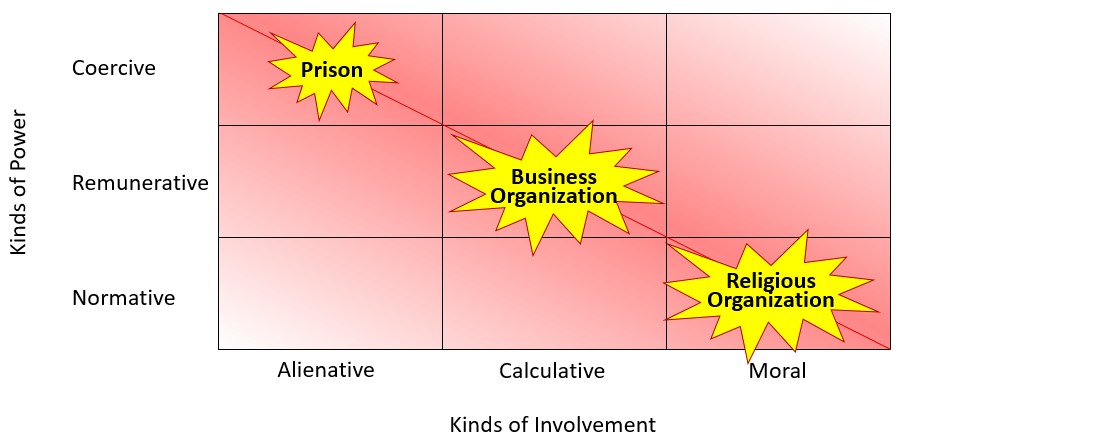Compliance is an important element of the relationship between those who have power and those over whom power is exercised. Research shows that it is power that ensures others are compliant. However, it is the involvement and engagement that establishes the attitude the subject will have towards the exercise of that power. The concepts of Compliance Typology and Bases of Power are especially relevant to PMOs where different approaches are required are to apply different types of power – often to people that may be more senior in an organizational hierarchy.
What is Compliance Typology?
Compliance topology was a concept developed by Amitai Etzioni in 1965. He created a typology by combining three types of power with three types of subject involvement. These were portrayed in a 3×3 matrix as shown below:
-
Coercive Power was described as involving the potential use of physical force to gain compliance (e.g. a master/slave relationship).
-
Remunerative (or Utilitarian) Power was based on rewards and sanctions such as a system of payment and fines.
-
Normative Power requires the subject to believe that the authorities have a right to govern and exert power.
-
Alienative Involvement means that the power subject disagrees with the power holder and submits against his or her will – usually out of fear.
-
Calculative Involvement refers to the subject’s choice to comply, either in expectation of a reward, or to avoid sanctions
-
Moral Involvement is the result of agreement based on social norms of a value system.
As the matrix suggests, the relationships on the diagonal line are most frequently seen. For example, where the involvement is highly alienative, a coercive power may be the only effective means of power. Other combinations are seen in organizations, but Etzioni notes that organizations tend to strive towards a congruent approach (that is to say – an approach along the diagonal line).
Whilst Etzioni’s model can help understand why employees are willing to follow directions or not, the boxes are very broad. Most business would expect to be in the center box most of the time, although those in the third-sector, politics, medicine and science may push towards the bottom right. The model is useful, but tighter classifications would allow more critical thinking and assessment. For this reason, organizations tend to use French and Raven’s Bases of Power, which offers six classifications.
What are Bases of Power?
John R. P. French and Bertram Raven developed their five Bases of Power in 1959, and added a sixth in 1965. They are:
-
Coercive Power uses the threat of force. It should be noted that this does not necessarily mean physical force, but can also include types of social, emotional or financial.
-
Reward Power focuses on the ability to provide rewards. These may not need to be financial, but can also take the form of social recognition.
-
Legitimate Power is power that comes from position or role. Your CEO has Legitimate Power. Your parents have Legitimate Power.
-
Reference Power is derived from the organizations or tribes to which you belong, such as trade unions, charter groups and meetups.
-
Expert Power is where expertise is the source of power (knowledge is power). Expertise is limited to the area of expertise eg Doctors or Lawyers.
-
Informational Power comes as a result of possessing knowledge that others need or want. It is often short-term: once you have shared the information you no longer have power.
When to use Compliance Typology and Bases of Power
Many people who work in the PMO space are familiar with stakeholder analysis – most often when devising communication strategies. However, it is important for PMOs to also consider their Bases of Power, the bases of those whom they are are engaging with, and how they align with the organizational typology. Consider rolling out a new timesheeting process, where employees are required to complete a timesheet every week. This is likely to meet with resistance. As PMO, you may not have legitimate power over the employees. Power is likely to be limited to Reference power (the power derived from being part of the PMO team) and Coercive power (naming and shaming individuals who do not comply). But there are other types of power that can be put to good use in this situation. Expert power can be used to influence leaders – who can in turn use Legitimate power to support you. Alternatively you could consider a reward scheme that recognizes consistently diligent employees. Power should also be considered when you are undertaking a compliance role with Project Managers. Too often in these situations the Project Manager sees the PMO using Coercive power: The PMO Police! However, approaching compliance using Expert, Informational and Reference power may produce more positive long term results if your organization is one that strives to be closer to the bottom-right of Etzioni’s matrix.
